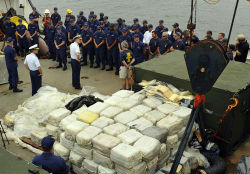In her book Mares de Cocaina (Seas of Cocaine), author Ana Lilia Perez explores how and why maritime drug trafficking has become the most common form for Latin American criminal groups to transit cocaine internationally.
InSight Crime talked with the Perez about some of the most revealing aspects of the book, and the impact of maritime drug trafficking on organized crime in Latin America. She also spoke of the failings by countries in the region to stem the tide of sea trafficking, and how governments could more effectively combat this security threat.
The Scale of Maritime Drug Trafficking
Seas of Cocaine states that 70 to 80 percent of cocaine consumed worldwide is trafficked at some point via sea. Perez told InSight Crime she calculated this figure by compiling statistics from the United Nations Office on Drugs and Crime (UNODC), carrying out interviews with European police units, and through personal research.
Assuming that percentage is accurate, it suggests maritime trafficking is deeply integrated into the operations of transnational drug trafficking groups in Latin America. Indeed, much has been made of the resurgence of drug trafficking in the Caribbean in recent years, which is often facilitated by fishing boats or island hopping go-fast boats. In response to this growing threat, in January 2015 the United States announced the first strategic plan of its kind to combat drug trafficking through this sea corridor.
SEE ALSO: Coverage of the Caribbean
However, less attention has been given to the reported significant increase in drug trafficking along the Pacific coast. Mexico’s Sinaloa Cartel has such a tight grip over the Pacific, the drug cartel can charge “derecho de piso” — a fee for permitting drug traffickers to operate in a certain area — off the country’s western coast, the book states.
The rise in maritime cocaine trafficking has previously been charted by Ameripol, an association of police forces from around the region, which labelled it “the biggest drug trafficking threat” in the region in a 2013 report.
As maritime trafficking has increased and the European market has grown, coastal European countries such as Belgium have seen major upticks in the amount of cocaine seized in recent years. Perez told InSight Crime this increase in transatlantic drug trafficking is due to the combination of a saturated US consumer market and higher wholesale prices for cocaine in Europe.
Corruption: Maritime Drug Trafficking’s Primary Enabler
According to Perez, corruption among sea border agents and port officials in countries such as Mexico is a principal factor in the rise of maritime drug trafficking.
“Corruption is the motor that enables maritime drug trafficking to grow,” Perez said.
The author went on to state, “If there was no corruption, it would be impossible that drugs could enter countries with even the lowest levels of corruption.”
According to Perez, corrupt officials in Mexico have facilitated the cartels’ operations by passing them intelligence information gathered from the US Drug Enforcement Administration (DEA) that identifies drug-laden ships. Transnational drug trafficking groups are not just limiting their scope of influence to Latin America, either. Perez told InSight Crime in some cases German officials have been corrupted by Mexican cartels.
SEE ALSO: Mexico News and Profiles
However, in many countries it is a lack of resources at seaports, not just corruption, which is driving maritime drug smuggling. The vast amount of legally transported goods arriving by sea into the United States makes it impossible to inspect more than a small percentage of the containers reaching its shores every day (pdf). Recent budget shortfalls have also negatively impacted the US military’s ability to combat maritime drug trafficking.
On top of that, Perez indicated to InSight Crime that organized crime groups in Latin America were increasingly opting to use sea routes in part because of the sustained security crackdown on overland and aerial drug trafficking in the region.
Policy Recommendation for Latin America: Towards a European Model
According to Perez, the failure of some Latin American countries to coordinate multilateral strategies to combat sea trafficking is also a key factor in its rise.
“The so-called war on drugs in Mexico is failing because there is no coordination on the international level against maritime drug trafficking,” Perez said.
Perez suggested greater cooperation and intelligence sharing between governments in the region, such as that seen in Europe, would offer advances in combating maritime drug smuggling. The Maritime Analysis and Operations Centre – Narcotics, based in Lisbon, Portugal, is an initiative comprised of seven European Union (EU) countries that “support, plan for and task operations to interdict illegal drugs” that are transited by air or sea in the region.
Such an integrated interdiction effort would probably prove more difficult to implement in Latin America, however, where political ties are not as strong as in the EU. The mixed policy positions on drug consumption would likely have to be smoothed out before governments in the region could come to a consensus on where to focus their anti-narcotics resources.

